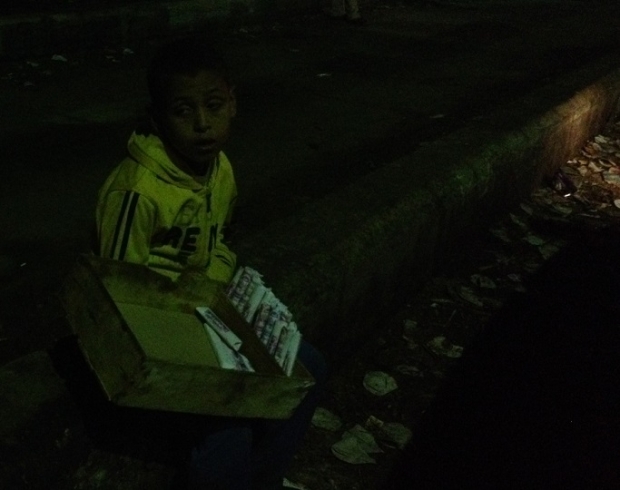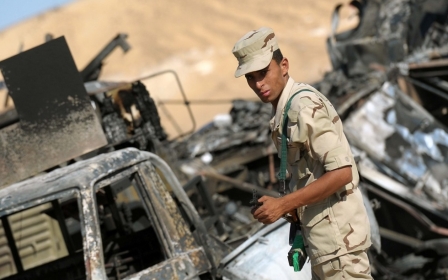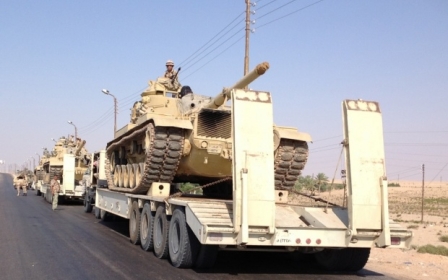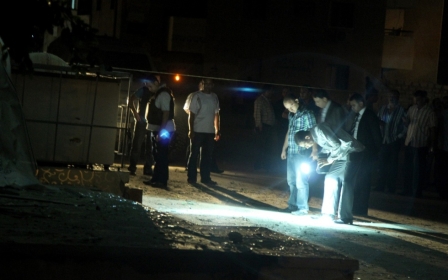Sinai hit hard by Egypt’s child labour problem

SINAI, Egypt: The worn-out plastic sandals on his feet looked like they have travelled a great distance - to school, to his work and to his home, and everywhere in-between.
At 3am, he is stood shivering in the cold Sinai Desert night air, as he tries to sell his wares to truck drivers in a rest area. “Tissues for two pounds,” said 11-year-old tissue-seller Karim Mustapha.
“This is what I do right now to support my sick father and mother,” said Karim, who is just one of 2.7 million Egyptian children involved in such labour in Egypt.
This a meagre source of income for the Mustapha family - they are not on the agenda of any organisation in Egypt, so do not receive any donations from charities or welfare groups - and are among one of the poorest groups in the population who have no other option but to send their young children to work.
His tissues - for two Egyptian pounds (approximately $0.28 cents) - gives him a profit of just $0.7 cents. In one night, if he is lucky, he could make a profit of $1, for his family. But he knows that he has to compete with other children selling tissues too.
“I have to be very visible to all the drivers wherever I see them,” said Karim. His tactics involve standing on the tip of his sandals, waving to passing cars, and occasionally knocking on car windows.
The designated truck-stop, for vehicles heading to the Suez Canal, is close to where Karim lives. In the hope of finding new customers, he takes the ferry, together with the passing cars, to the other side of the canal.
“I have been waiting for this Eid holiday to come, so I can celebrate with my family,” he said. “My dad has a lot of debts to pay off, and I must work with him to help repay them.” Karim comes from a tribal community, in Egypt’s Sinai Peninsula, where it is difficult for women, like his mother, to work. Her traditional role is still to stay at home and raise the family, which can be very difficult especially as there are no child welfare groups to help families such as Karim’s.
For the people on the ferry, child labour is not seen as a problem - it is often the only way to survive. But most people have acknowledged that the situation in Sinai has grown worse because of the deteriorating security situation and tensions rising between Egyptian military and Bedouin clans known locally as the “Arabs”.
The tensions mean that most international relief and aid is not reaching many of Sinai’s 1.4 million people and especially those in the north and east where the security situation is the worst. Many families are therefore forced to send their children out to work just to make ends meet.
When the ferry docks, Karim departed with whatever he has managed to earn that shift and any boxes of tissues he has left. He plans to meet up with his younger brother, eight-year-old Mohammed Mustapha, who has been sat in the middle of the road, selling salted watermelon seeds.
Both boys return home, they have made little profit today. When school is open, they attend. But, for the rest of the time this is the only education they have. Their knowledge mostly consists of where trucks drive, where and when the ferry stops, and how to persuade customers to buy their meagre wares.
Hazardous circumstances
In Egypt, many children are known to be engaged in the worst forms of child labour, often in extremely hazardous circumstances, from working with machines in factories, to carrying heavy loads in agricultural fields.
These children are forced to work because of their family’s poor economic situation, but the situation is compounded by employers, many of whom exploit these dire social circumstances. It is common for children to be forced to work long hours - in the heat of the day, or the cold of the night - for extortionately low pay, when, legally, these children should not be working, at all.
Human rights groups and the United Nations have documented many cases where children are either verbally threatened or physically abused by their employers, and in agricultural work are often forced to spray dangerous pesticides on farm crops. In factories children are exposed to industrial dust, chemicals, and toxins. Most of these cases involve production and construction.
Mohammed is aware that many of his classmates must survive by street peddling, shoe-shining, collecting garbage, or begging. Though sex-trafficking/tourism rarely happens in a conservative society such as Sinai; poverty has forced some families to sell their female children into temporary marriages.
In Egypt, 2.7 million out of around 11 million children are involved in the labour market. The International Labour Organization (ILO) and Egypt’s Central Agency for Public Mobilization and Statistics (CAPMAS) announced that 13 per cent of Egypt’s school-age population have dropped out of school to engage in labour - girls in rural areas such as Sinai are suffering the most because they have limited access to education.
Rayan Abdelhadi, a 25-year-old government employee, acknowledges that this is an all too familiar situation in Egypt “Wherever there is corruption, there is child labour and poverty,” he said.
He explained that poverty forces families to send their small children to work – “we work day and night, just to survive”.
For example, Abdelhadi earns 400 Egyptian pounds (approximately $55 a month). He uses his electricity modestly, but still his latest bill was the equivalent of $20.
“What are you expected to keep for water, gas and daily expenses after that?” he said.
Egyptian law permits children older than 14 to participate in the workforce on the condition they do not perform hazardous or arduous tasks. But there is a high preference among employers to employ children who cause no trouble, keep quiet, accept low payment and expect no insurance.
Two weeks ago both the European Union and the World Food Programme contributed $75m to fight child labour by providing food to Egyptian children in 16 different locations.
“The EU is delighted to join hands with WFP to work on combating child labour, with a particular emphasis on girls’ access to education,” said Ambassador James Moran, Head of the EU delegation in Egypt.
But this can only hope to scratch the surface of Egypt’s child labour problem.
Karim said that if it were not for his family’s poverty, he would not be standing on dark and dangerous roads at night, selling tissues. Sadly, unless security improves in Sinai, it looks like Karim will be peddling tissues for many more nights to come.
Middle East Eye propose une couverture et une analyse indépendantes et incomparables du Moyen-Orient, de l’Afrique du Nord et d’autres régions du monde. Pour en savoir plus sur la reprise de ce contenu et les frais qui s’appliquent, veuillez remplir ce formulaire [en anglais]. Pour en savoir plus sur MEE, cliquez ici [en anglais].





